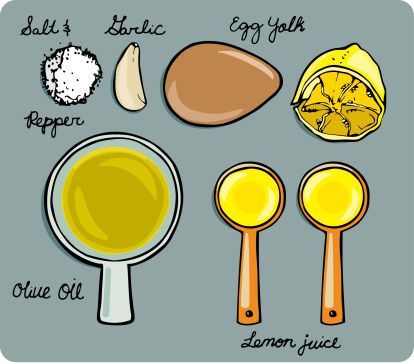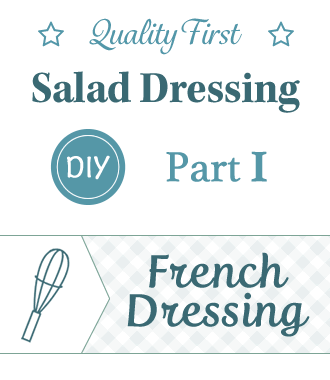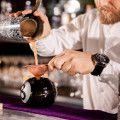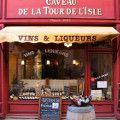Salad Dressings DIY Quality: Part I French Dressing
Most people have in their fridge a bottle of salad dressing.
What they don’t know is that it makes them sick, and I’m gonna show you why.
There is a lot of advertising and a lot of effort out there to talk anyone and everyone into buying into of literally thousands of salad dressings. It is a big, big business and the industrial food production complex want to keep everyone a chained economic slave to that convenient bottle of salad dressing.
Well, I am here here to convince you to use the cold steel chisel of common sense to strike off those chains.
This is [Part 1] of the salad dressing series: [Part 2]➞ The Basics, [Part 3]➞ Caesar Salad, [Part 4]➞ Spanish Paprika Dressing.
I am here to bring you the truth of most bottled salad dressings. This blog post is going to teach a little, make you think a lot, and probably get you a little mad at industrial food complex, those corporations that are willing to make consumers just a little sick to pad their profits.
Never sick enough to stop buying, of course, but the healthiest product is never the first priority of these corporations … profit is.
In today’s world: Return to your roots where you control Food quality & dodge poison.
At Qualifirst the first priority is the quality of the product.
First, a little Dressing background:
Dressings have been around a long, long time, but always made in the kitchen, never I.
Fermented sauces were made in Asia thousands of years ago. They were fermented as a way of stretching salt, then an expensive commodity. One of those sauces was called jiang (酱) that would later become soy sauce in the period between the 3rd and 5th century.
Babylonians had oil and vinegar for salad dressings. Egyptians also had salad dressings, again oil and vinegar plus some spices.
So we can agree that throughout history, man has actively used dressings, fermented or oil + vinegar + spices.
Emulsion Stability:
Then what caused the spark, shifting oil & vinegar to store-bought dressings?
The answer appears to be: Mayonnaise!
We could just blame the French (always a good strategy) but the origin of mayonnaise is a hot topic of debate.
_-_Portret_van_maarschalk_hertog_Richelieu_-_Lissabon_Museu_Calouste_Gulbenkian_21-10-2010_13-34-54.jpg?access_token=13f78a94-c074-4508-afac-a9abce634b3e)
This painting above is a French nobleman – Armand de Vignerot du Plessis – bringing it back from the city of Mahon in Spain when he defeated the British in 1756.
Makes sense, since the story calls the sauce ‘Salsa Mahonesa’ in Spanish and ‘Maonesa’ in Catalan. Unfortunately there is little documentation to support that idea.
That bastion of all things culinary, the Larousse Gastronomique, claims probably correctly that the stable emulsion of egg yolks and oil with an acid (vinegar or lemon) is a Mediterranean invention with the name coming from the Old French word of egg yoke ‘moyeu’ and the supporting documentation is quite good for this since that amazing French sauce ‘Aioli’ has a long history.

Aside from the cool word with five letters and four vowels, Aioli is a classic sauce with basically garlic, oil, egg yolk, lemon juice, and salt with some seasonings depending on the region.
So it turns out that blaming the French in this case is a good strategy 🙂
Allowing bottled dressings:
The thing about mayonnaise: it’s a stable emulsion when properly made. A mayonnaise can have up to 85% oil before breaking up.
This stability kicked open the doors to making stable, bottled salad dressings.
Popular restaurants started bottling their best salad dressings so that their customers could take them home.
A famous example is Mr. Richard Hellmann, who owned a popular deli in New York in 1912. The mayonnaise he made for his sandwiches and salads became so popular he sold his blue ribbon mayonnaise in wooden containers. Demand increased, so he started selling his mayonnaise in glass jars. Quite quickly the sales of mayonnaise outstripped the deli business.
Steve Henson created the most popular brand of salad dressing in North America called Hidden Valley Ranch Dressing, a dry seasoning mixed into (you guessed it): mayonnaise and buttermilk.
How crazy were people about Hidden Valley Ranch Dressing? In the late 1950’s people poured it on steak and ice cream … wow …how crazy is that? Today the #1 dressing in North America.
This trend proved irresistible to consumer-convenience-oriented industrial food companies that could see profits in the future. So it was in 1925 that the Kraft Cheese Co purchased a few regional mayonnaise manufacturers as well as the Milani Company, launching their bottled dressing: French Dressing, which was basically an oil and vinegar base flavoured with tomato and paprika.
Mayonnaise sparked the trend of convenience dressings joining mayonnaise and ketchup as pantry necessities.
According to industry statistics the 6.3 million gallons of pourable salad dressings that were sold in 1950 tripling by 1960, doubled again by 1970 to sit at 34.3 million gallons. By 2000 it was over 60 million gallons. Today it is insane.
Rather than write a book on salad dressings we can see that basically all of these dressings are: Oil, vinegar, spices, seasonings, and knowledge.
Two other facts:
There are two other facts about bottled salad dressings today:
They are generally loaded with low-cost marginal ingredients.
They are expensive compared to any DIY dressing.
The use of High Fructose Corn Syrup (more on this later …), of GMO ingredients, and other horror stories about what today’s industrial food companies will put in the bottle in their quest for profit at the expense of consumer health has created a new category of consumer: the anti-salad dressing consumer aka ‘a smart person‘.
Highly intelligent articles such as “Zen and the Art of Making Aioli Sauce” from 2012 have empowered DIY salad dressing makers.
It is EASY to make your own dressing, you will get a HEALTHIER result, and it WILL TASTE BETTER.
This is why Qualifirst, besides selling ingredients that allow you to make the best salad dressings in the world, only sells “all natural, sugar free & hard to make at home” dressings like Vino de Milo and NaGo.
Our customers know that the high-quality ingredients such as our Olive Oils and different wine-based vinegar gives them the tools for a superior tasting dressing, a healthier dressing, a lower cost dressing, and one additional benefit: the pride of DIY.
I recently visited a friend and his whole family loves French Dressing, buying different store brands. There were three different kinds in their fridge, each about half full. I threw them away, recycled the glass, and made a batch of French Dressing from Scratch.







